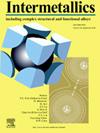Optimizing strength and minimizing anisotropy in Fe-Cr-Al-Nb alloys via Fe2Nb particles
IF 4.3
2区 材料科学
Q2 CHEMISTRY, PHYSICAL
引用次数: 0
Abstract
Controlling the texture and grain size of Fe-Cr-Al alloys is essential for enhancing mechanical properties. Here, the effect of Nb on the texture evolution and the anisotropy of mechanical properties in Fe-Cr-Al alloys were investigated. Compared to the annealed Fe-Cr-Al alloy, the yield strength of the annealed Fe-Cr-Al-Nb alloy increased from 430 MPa to 540 MPa with nearly identical rolling and transverse tensile yield strengths. Transmission electron microscope results indicate that the Nb could form Fe2Nb particles with an average radius of 50 nm in matrix of the annealed Fe-Cr-Al-Nb alloy. The electron backscatter diffraction results indicate that the grains of the Fe-Cr-Al-Nb alloy are significantly refined by Fe2Nb particles, and the α-fiber and γ-fiber textures are weakened, promoting texture randomization. The strengthening calculations indicate that compared to annealed Fe-Cr-Al alloys, the increase in the yield strength of the annealed Fe-Cr-Al-Nb alloy is attributed, in sequence, to dislocation strengthening, Orowan strengthening by particles and grain boundary strengthening. As a result, the annealed Fe-Cr-Al-Nb alloy achieves an increase in yield strength while reducing anisotropy. This finding provides insights for the development of Fe-Cr-Al alloys.
通过 Fe2Nb 粒子优化 Fe-Cr-Al-Nb 合金的强度并最小化各向异性
控制Fe-Cr-Al合金的织构和晶粒尺寸是提高合金力学性能的关键。本文研究了Nb对Fe-Cr-Al合金织构演化和力学性能各向异性的影响。与退火后的Fe-Cr-Al- nb合金相比,退火后的Fe-Cr-Al- nb合金的屈服强度从430 MPa提高到540 MPa,且轧制屈服强度和横向拉伸屈服强度基本相同。透射电镜结果表明,Nb在Fe-Cr-Al-Nb合金退火后的基体中形成平均半径为50 nm的Fe2Nb颗粒。电子背散射衍射结果表明,Fe2Nb颗粒使Fe-Cr-Al-Nb合金晶粒明显细化,α-纤维和γ-纤维织构减弱,促进织构随机化。强化计算表明,与退火后的Fe-Cr-Al合金相比,退火后Fe-Cr-Al- nb合金屈服强度的提高依次为位错强化、颗粒Orowan强化和晶界强化。结果表明,退火后的Fe-Cr-Al-Nb合金在降低各向异性的同时,屈服强度有所提高。这一发现为Fe-Cr-Al合金的发展提供了启示。
本文章由计算机程序翻译,如有差异,请以英文原文为准。
求助全文
约1分钟内获得全文
求助全文
来源期刊

Intermetallics
工程技术-材料科学:综合
CiteScore
7.80
自引率
9.10%
发文量
291
审稿时长
37 days
期刊介绍:
This journal is a platform for publishing innovative research and overviews for advancing our understanding of the structure, property, and functionality of complex metallic alloys, including intermetallics, metallic glasses, and high entropy alloys.
The journal reports the science and engineering of metallic materials in the following aspects:
Theories and experiments which address the relationship between property and structure in all length scales.
Physical modeling and numerical simulations which provide a comprehensive understanding of experimental observations.
Stimulated methodologies to characterize the structure and chemistry of materials that correlate the properties.
Technological applications resulting from the understanding of property-structure relationship in materials.
Novel and cutting-edge results warranting rapid communication.
The journal also publishes special issues on selected topics and overviews by invitation only.
 求助内容:
求助内容: 应助结果提醒方式:
应助结果提醒方式:


